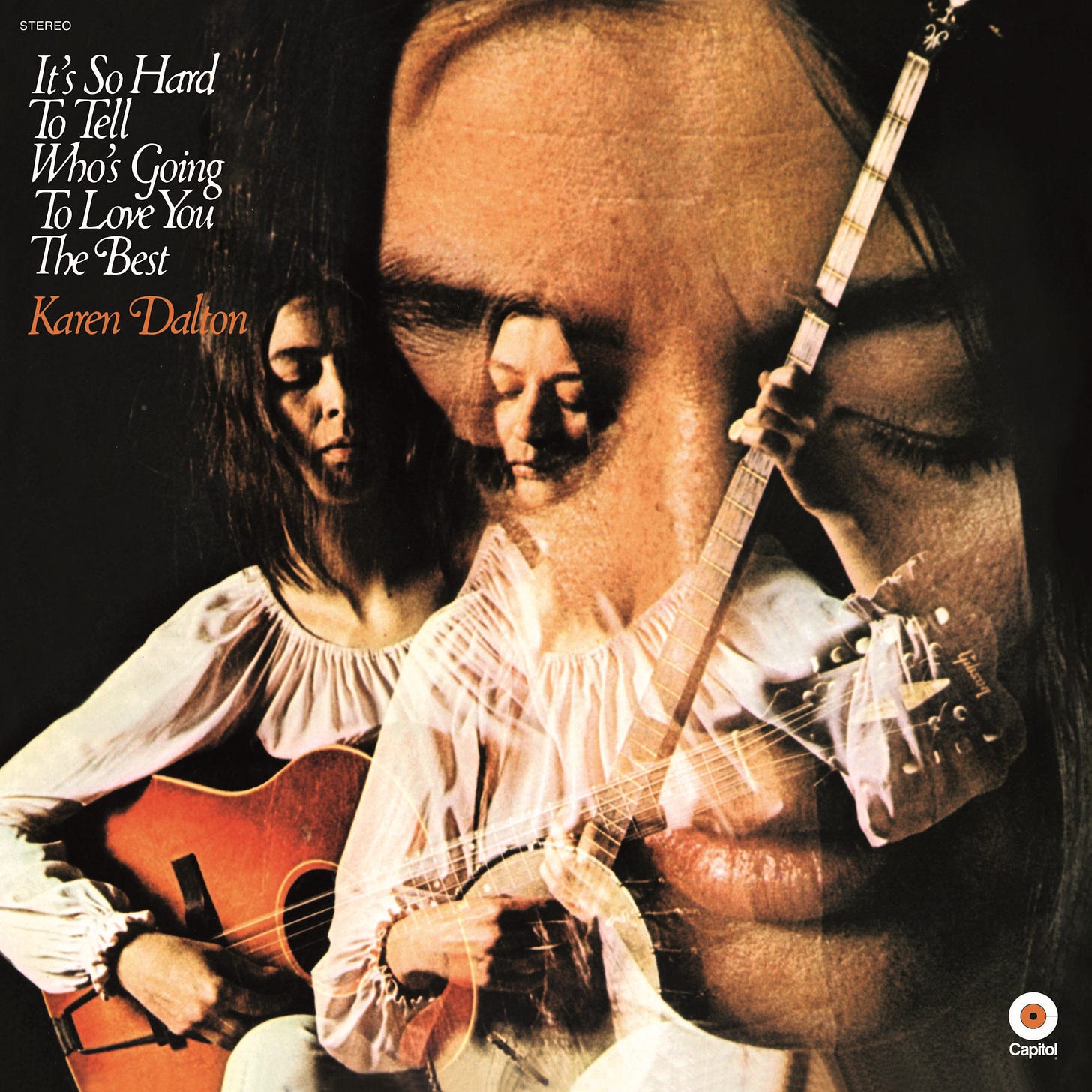Dear CSTers,
I recently watched a terrific documentary (available on The Criterion Channel), called Karen Dalton: In My Own Time, and I might now be a little obsessed with the late American folk singer Karen Dalton (1937-1993). Dalton was a complicated person (who isn’t?) but one thing’s for sure: she was a great American artist.
A self-invented musician from Oklahoma who became an overnight sensation in the early 1960s Greenwich Village NYC folk music scene, Dalton was naturally shy, hated the idea of fame and preferred playing music with her friends in the living room. She traveled to the East Coast just to find other people to play music with, not to get a record deal. It’s why so little of her incredible music survives: she wasn’t interested in recording or being a part of any culture industry.
The first thing you notice about Dalton is her absolutely one-of-a-kind sound: haunting, rasping, singing at the edge of her voice, finding her own phrasing unique to how she’s feeling in that moment. She sings like nobody else. Born in Enid, Oklahoma, her mother, Evelyn Carter, said “Karen could play any instrument she wanted to including a violin I once gave her. She taught herself how to sight-sing classical music or any other kind.” When she was 14 the family doctor took her parents aside and told them something about their daughter: “She’s a real artist.”
She had a unique voice, but that’s not to say she had no musical influences. In fact, to Dalton, music was all about influence. Her favorite music was the kind she grew up with and began to collect, song by song, over the years: traditional American folk music. Dalton arrived on the scene in Cambridge, Massachusetts in 1961 and quickly blew minds.
“In a world and scene of amateurs, semi-pros, and wannabes,” recalled admirer and fellow folk musician Peter Walker (see his book: Karen Dalton: Songs, Poems, and Writings), “Karen [was] the Real McCoy.” In 1961 Dalton and friend Richard Tucker unpacked their banjos and started playing. Their audience of aspiring musicians quickly realized something: Dalton wasn’t just playing folk music. She was folk music.
“She was one of the most authentic root sources of material for the folk movement,” Walker writes. “It was only many years later I realized she had been collecting her material since childhood in Oklahoma.” Other musicians recognized it, too. Peter Stampfel, of the folk group Holy Modal Rounders, wrote that “she was the only folk singer I ever met with an authentic ‘folk’ background. She came to the folk music scene under her own steam, as opposed to being ‘discovered.’
Karen Dalton didn’t just love traditional music, she loved the traditions themselves, which is to say that what she loved doing most was simply singing old songs in the company of others, learning songs from her fellow musicians, and sharing what she knew. This wasn’t a tradition of recorded music, it was more like swapping stories. For that reason, she only recorded only two albums, both of them more or less by mistake, all the songs recorded in one take, most notably on the 1969 record, It’s So Hard to Tell Who’s Going to Love You the Best, a collection of traditional songs.
Dalton moved to New York City to play music there and her talent was immediately recognized, though she resisted offers to record or even play live more often; she preferred to perform in somebody’s living room, singing with friends. It only made her more mysterious to her admirers, such as Bob Dylan. "My favorite singer...was Karen Dalton,” Dylan wrote in his autobiography, Chronicles. “Karen had a voice like Billie Holiday and played guitar like Jimmy Reed... I sang with her a couple of times."
Dalton lived in Boulder, Colorado for a while but eventually settled in Woodstock, New York. At some point in the late 1970s/early 1980s she contracted a mysterious illness that would later become known as AIDS. Flat broke, Karen subsisted with the help of her many friends in the folk music scene. In the close community of Woodstock, she became a kind of legend, supposedly the model for “Katie” in the song “Katie’s Been Gone” on the legendary Basement Tapes by Bob Dylan and The Band.
Dalton has the voice of what Greil Marcus called “Old Weird America,” the sound of traditional American collected by musicologist Harry Smith in his priceless three-volume contribution to history, The Anthology of American Folk Music (Smithsonian Folkways Recordings).
I’d never heard of Karen Dalton before seeing the documentary and I am so grateful I did. If you’re looking for something special, something heartfelt, and a voice that will break your heart, guaranteed… give Karen Dalton a listen. Here’s a poem of Dalton’s to close out:
POEM FOR STRUNG-OUT POET
by Karen Dalton
Not dead yet, not dead, and love not dead
fix a tragic mask on bitter spikes,
Gods unholy face may fall.
Gibber down bloody fallen tunnels
echoing all madness, not dead yet,
Crossing old rivers of no concern
Riding dreams behind comatose Indians
To holy countries of no rain.
Love, you are so beautiful
Sleeping through the first April storm
Remembering pain,
Unwatching eyes, remembering
Not dead yet.
Impaled on that utmost evil
Guarding overgrown gardens of forgotten paradise,
Waking in the cold green wind
It will be spring now, soon
It will be spring.
Thanks for reading, friends. Be well and make sure you get yourself plenty of continuous small treats. They make life worth living.
xo Buzzy







